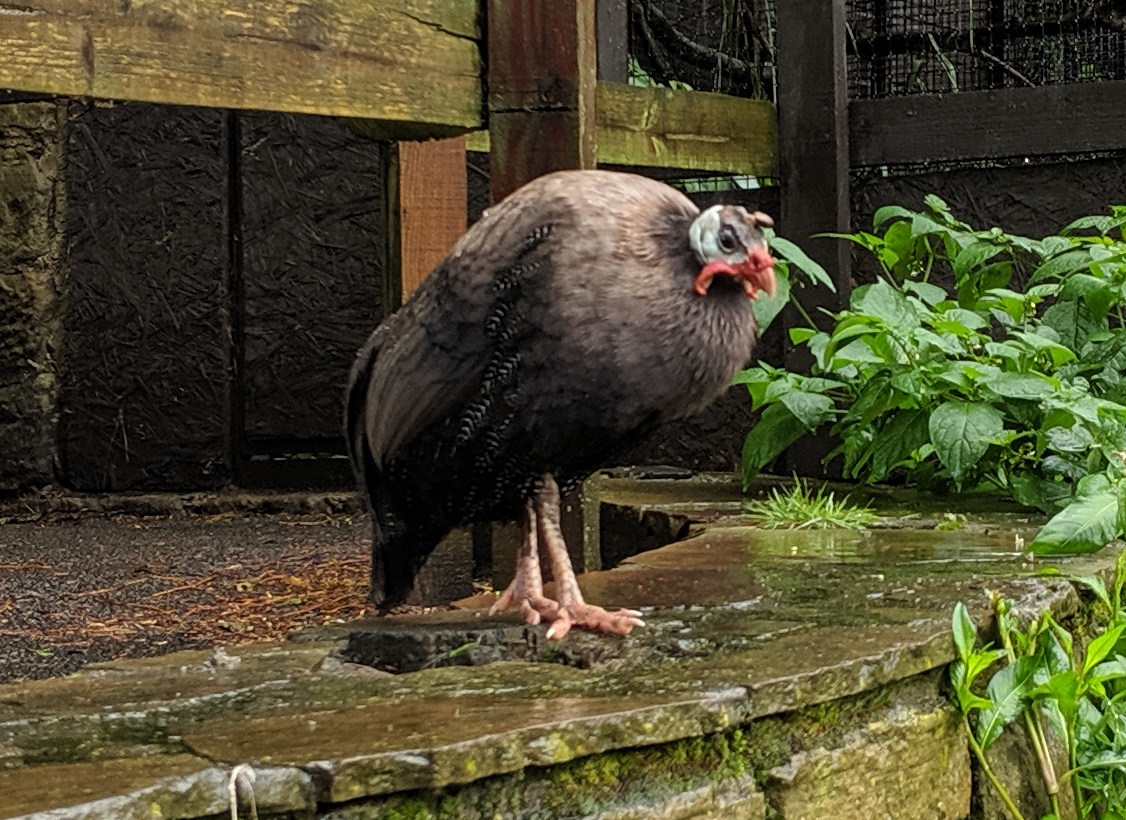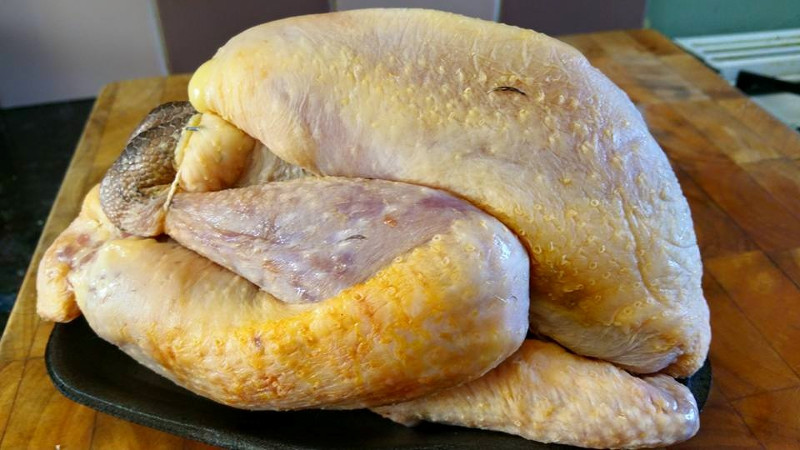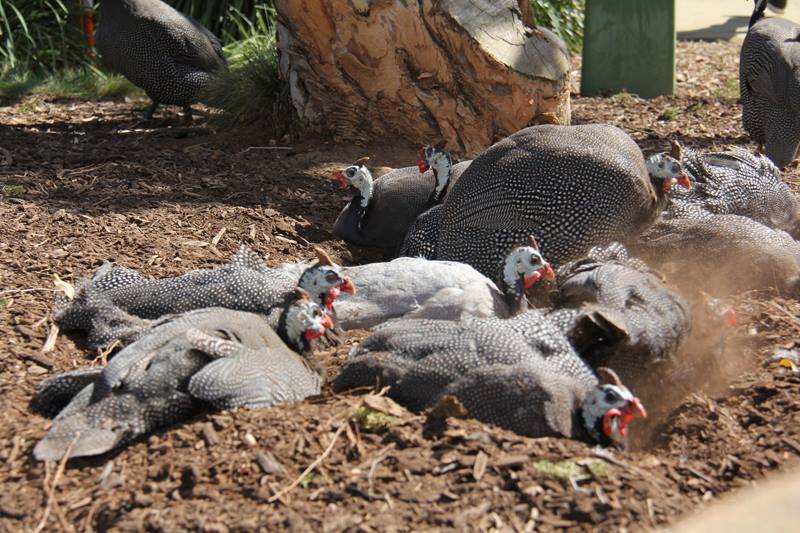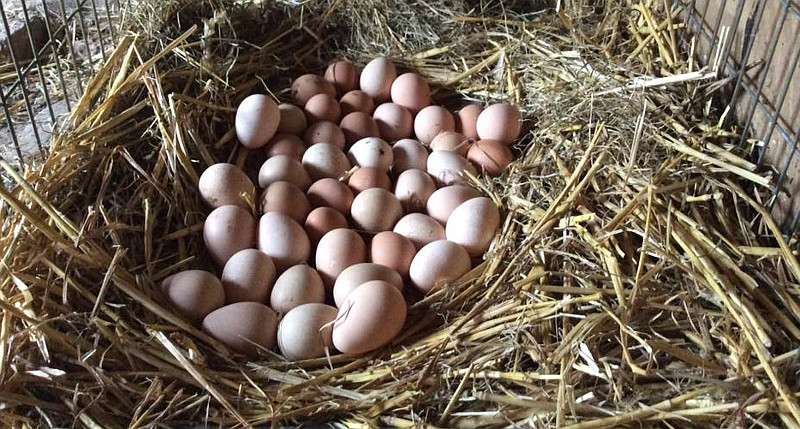Guinea fowl and their care.

Guinea fowl are known for their loud and distinctive calls, which can serve as an effective alarm system. They are active foragers, constantly searching for insects and seeds.
Guinea fowl can be quite hardy and are known for their ability to adapt to different climates.
The domestic Guinea fowl:
It is pronounce gin-ee fow-l. The Guinea fowl is a small partially domesticated fowl somewhat similar to a chicken or pheasant in size but with a stronger meat flavour. There are 5 types of Guinea fowl, family Numididae in the order Galliformes, with only one being raised for egg and meat production.
The Greeks and Romans are reported to be the first to domesticate guineas spreading them all over the Empire as a food source. They were not really domesticated at the time, just transported and released to be a food source. They are not that domesticated these days either and they really have to be kept on their terms as much as yours.
Guinea fowl might be a strange looking bird but they’re becoming increasingly popular in backyard flocks. The guinea fowl is extremely noisy and cannot be reared nearer to residential houses.
Below: Guinea fowl are hardy birds.

Many people love their Guinea fowl because the birds are full of personality but Guinea fowl aren’t for everyone and you need to think about how well they’ll fit your situation.
Guinea fowl are a game bird and kept primarily for three reasons, eggs, meat and their ability to eat vast quantities of insects. I would add a fourth reason, their amusement factor. They are endemic to the continent and rank among the oldest of the gallinaceous birds.
Special features of Guinea fowls include:
- Hardy birds.
- Suitable to many agro-climatic condition.
- Resistant to many common diseases.
- No requirement of elaborate and expensive housing.
- Excellent foraging capabilities.
- Consumes all non-conventional feeds not used in chicken feeding.
- More tolerant to mycotoxin and aflatoxin.
- Hard shell provides minimum breakage and good keeping quality.
- Guinea fowl meat is rich in proteins and low in cholesterol.
- They act as very efficient watch dogs and are constantly on guard.
- They will pick up a large part of their own food during the warmer months if given space.
- They eat less grain then most domestic fowl.
- They carry few of the diseases dangerous to other domestic fowl.
- Guinea Fowl eggs are considered a delicacy and have a good flavour.
- Guinea Fowl meat is classed as a game meat and described by many as half way between a free range chicken and a pheasant and commands premium rates.
Domestic Guineas as producers:
Guinea fowl is the common name of the seven species of gallinaceous birds, indigenous to Africa of the family Numididae. It is well adapted to life in Africa.
In many parts of the world, guinea fowls are raised mainly for their gamy flesh and solid shelled eggs. Guinea fowl has a taste similar to other game birds and has many nutritional qualities that make it a worthwhile addition to the diet.
The meat of a young guinea is tender and of especially fine flavour, resembling that of wild game. The meat is lean and rich in essential fatty acids. Guinea fowls have a high yield of 80% after processing with excellent meat to bone ratio.

Above: Guinea fowl trussed for cooking
The eggs are of excellent quality and the shells solid.
The feathers have value in the fly tying and arts and crafts markets.
Keeping Domestic Guinea Fowl:
Guinea fowl are native to the West Coast of Africa but the distinctive polka dot plumage, bald helmeted heads, and their insect eating appetites are earned the birds some supporters.
They are an insect and seed eating ground nesting bird that spends most of their day browsing grasslands and undergrowth. In the wild they are seen in flocks of up to 30 individuals
They’ll demolish all the garden pests for you but because they are generally surface feeders they tend not to scratch or uproot established garden plants. Do not them loose amongst you young plants or vegetable seedlings.
Below: Pugnacious and belligerent, they are very funny too watch, I spend far too much time watching mine make mischief.

There are native to Africa but were spread around Europe mostly by the Romans and taken to America with the early settlers.
They are a bit unusual in that they are both easier and more difficult to keep than chickens. They are too independent to make cuddly pets but their personalities and antics are highly entertaining and many people love them for their quirks.
They seem to eat less and are more thrifty birds than chickens and they do not scratch in the same way as hens preferring instead to potter around looking for insects, slugs, snails, caterpillars and grubs.
Some care is required and my Guineas are now kept in a covered run after they ate an entire hive of bees in a neighbours allotment.
Egg laying ability:
Domestic Guinea fowl eggs are smaller than hens eggs, by about a third, but have much the same taste and a surprisingly large yolk. They also have a very thick shell and require a crack with a knife to break them.
Nest boxes are not needed. Guineas nest in a dip in the floor. They prefer their own spots.
Below: Most Guinea fowl will lay about 120/140 eggs a year but if allowed to go broody they will stop laying. Guineas will also maintain this level of production for 3 or 4 years.

Guinea fowl is a promising genetic resource for evolving a low input-grain saving poultry alternative for production especially in the developing world. The rearing of guinea fowl is a potential alternate poultry system.
The Guinea fowl is descended from the wild species of Africa. The fowls derive their name from Guinea, part of the west coast of Africa. As already mentioned guinea fowls are indigenous to Africa, but they were brought to Europe during middle ages. In Africa, guineas are hunted as game birds; and in England they are sometimes used to stock game preserves.
Guineas have been domesticated, if you can call it that, for many centuries. Ancient Greeks and Romans raised them for table birds. To date, guineas are ubiquitous and are found the world over. It is believed that they might be more popular were it not for their harsh and seemingly never-ending cry, and their flighty disposition.
When the Guinea Fowl start to laying the spring we advise eggs should be collected every day and a dummy eggs left in the nest to encourage them to lay all season up until late October depending on the weather conditions.
It is important that the eggs are collected when the hen is not in the vicinity of the nest or she may move locations, some will lay with chicken other preferring to make their own nest in a hedge or clump of weeds.
The eggs are heavy shelled and the size of a small hens egg they have a large yoke and many people regard them as superior to a hens egg. The eggs take 25 to 28 days to hatch and are incubated in the same way as a normal chicken, we tend to prefer a broody chicken if possible but also hatch out many in incubators.
The common guinea is a bird that weighs about 2 kg when mature. The male is comparatively not as heavy as the female. The difference in size is, however, minute and does not make it possible to differentiate between the two sexes.
Colours:
Wild guineas are all the same type, either pearled or vulturine.
People who keep Guinea Fowl like to specialise in one colour whilst others prefer a mixture. The birds come in a large range of different types and 21 different colours have been identified, they fall into 3 groups:
Fully Pearled with small white dots all over.
Partially Pearled with white dots in some areas.
Solid Colours and no dots at all.
I have Pearl Grey, Pearl Lavender, Royal Purple, Pearl Buff, Chocolate and White.
Birds can also be Pied which is when a guinea has a coloured back and white front and sometimes it extends to the wings. There is an excellent colour chart with photographs on the Guinea Fowl International association page available from my links page.
The head and neck of the fowl are bare, but there may be some wattles. The wattles on a male guinea are much larger than on the female.
Vulturine Guineas are large and not domesticated at all and need to be kept in covered runs.
Caring for Guinea fowl:
There are a few things you need to think about before you consider guineas and make no mistake Guinea fowl are more difficult to keep than chickens.
- They are noisy and will make a ruckus at any hour of the day or night which may annoy your neighbours. Some people like this as it is a deterrent for burglars and predators.
- They tend to be monogamous and choose a mate for the breeding season which means breeding them is more expensive as you need more males. The breeding ratio is 1:1
- They fly very well and do whenever they want to so wing need clipping or birds need to be pinioned. It is actually illegal in the United Kingdom to free range guineas that have not been pinioned. And a vet has to do it, you can't.
- Guineas are far more likely to disappear in spring into the hedges to make a nest and be broody.
- Like any other poultry they will need feeding, housing and protection. These things cost you money and time and guinea fowl probably more so initially.
- Guinea fowl range much further than other poultry.
- Guineas eat more greens and these will need to be provided during the winter months by growing fodder or sprouting seeds.
- They are not as destructive as chickens but definitely DO scratch, which can damage some plants, foliage and surroundings with their dust bathing and antics.
- They are less feed intensive and generally more thrifty than chickens. Mine seem to prefer whole grain feeds which are cheaper.
- I have found them to be more hardy although they really do not like snow.
- The eggs are amazing with really firm whites and large yolks for the size of egg. Hands down my favourite egg. Especially as i love poached eggs.
- I have witnessed on more than one occasion a flock of Guinea Fowl rout a fox with their calls.
How many Guineas should you get?
You can keep as many you need for eggs or meat but them in small groups of no more than 30 birds or it may begin to cause problems. 3 Guinea fowl is the minimum as they get stressed in small numbers.
You will need more guineas than chickens if you are keeping them for aggs as they produce a smaller egg in smaller numbers.
If you need 12 eggs a week then get 3 Guinea fowls and if you need 24 eggs a week then get 6 birds and so on. They are also seasonal layers, mine go from late February a lay until October or early November.
My recommendation if you want them purely for eggs is a flock of no more than 30. And do not stock them at more than 30 birds per acre.
In nature they flock to this number of guineas out of the breeding season and feel comfortable in groups about this size. More may cause fighting. I currently have an egg flock of 27 guinea hens and they get on just fine with no males in the group.
Keep less if they are confined, they seem to get on each others nerves if locked in. Consider six or eight to be the limit if they are not to be ranged and limit to one male.
Feeding Guinea fowl:
Guineas eat all insects and actively hunt for them in all nooks and crannies. They do graze but are not destructive in a garden like chickens. They should be allowed access to grass pasture and prefer to free range although we keep ours in a movable covered run to avoid conflict.
I have witnessed a guinea fowl stuffing itself on a mouse so they have a varied diet. They will eat small grains not whole maize and are low maintenance feeders.
Mine have never seen snake as we live in the depths of the Yorkshire Dales and there are not many about. They will eat small snakes and kill bigger ones.
They will hunt high and low for any insects, mine cost me a fortune once when they spent the morning hoovering up all the bees from a hive in the allotments next to me a few years ago so do keep an eye on them.
Their need are similar to that of a chicken, I have seen them eat pellets but if they have the choice they eat grains.
- Fresh water daily.
- Grit and shell, the same as for chickens.
- Greenery or pasture.
- Whole grain feed with some higher protein additions like sunflower kernels, safflower seed or buckwheat.
They produce less eggs per year than chickens and they are smaller so their feed requirements are much less.
In the wild state, plants play an important role in Guinea nutrition. They can cause damage to crops, especially to young plants and sprouting seeds. While feeding it does not scratch with its claws, but uses its beak for tearing with abrupt head movements, a form of behaviour that leads to tremendous feed wastage from the feeders, especially when mash is used.
The guinea fowl is more resistant to hot weather than chickens, and raising it requires a higher temperature. It withstands transportation better than the chicken.
Housing and nesting for Guineas:
Guineas like to roost up high so the bars should be in the roof of the shed. Your covered run will depend of where you live in the world and which predators you need to keep out.
They're not fussy about where they lay their eggs and you'll find them under bushes or even on open ground. It is not uncommon for me to find 6 or eight birds in a heap in the corner of the shed all laying and egg in a communal nest so do not expect the same of them as you do your chickens.
When broody and they decide to build a nest it will likely be a well hidden spot in some long nettles or thorns or somewhere equally inaccessible! Here they scrape a shallow hole in the ground and will lay an egg in the nest almost every day.
The nest may be used communally and it is quite common for a guinea to try and sit on 30 or more eggs in a heap. this is one reason some people see them as poor mothers.
Rearing Systems:
Three methods of rearing guinea fowls are free range, semi-free range and intensive system. When kept intensively, low light intensity should be used to reduce possible flightiness.
Give them as much space as possible, but roof the run or they will fly out (unless you clip their wings). It is said that fertility drops when guineas are kept confined, so they are probably much happier if allowed free-range.
Free range:
This is the predominant rearing method. Free range guinea fowl constitutes an important resource for resource-poor farmers as well as small scale backyard flocks.
Darkness and presence of perches reduce the bird's timidity where it likes to hide and to remain motionless when afraid. As a result, darkened buildings with reduced light intensity allow large numbers of guinea fowls to be raised.
Semi-free rearing:
This involves keeping the keets in a rearing house to start and then being transferred to shelter, equipped with perches etc and access to the outdoors generally surrounded by a fence of at least 2m high. Pinioning of Keets, either by removing a wing tip or trimming the feathers is generally required to stop birds flying away.
Intensive rearing:
In this type of rearing birds do not have access to an outdoor enclosure. For rearing on soil, densities are from 3 to 5 birds per square metre, and the houses are usually equipped with perches.
In modern breeding units Guinea fowls are usually reared in batteries and artificially inseminated. A method with it's own moral issues.
It is timid, with a more gregarious behaviour than that of the chicken. fits of panic with crowding together of birds which can cause heavy losses.
Guinea Fowl do make good companion birds for other domestic birds as they tend to be non aggressive to birds of a similar size and do not carry many of the diseases, parasites and germs that Chicken, Turkeys, Ducks and Geese are susceptible.
